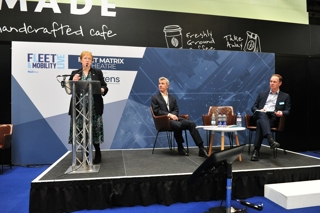CDAs will be suspended while an investigation takes place; then further action is taken if necessary.
The company is comfortable taking such a strict line because of the rules it has implemented.
Every CDA is briefed on Tesco’s expectations and they are aware of the consequences.
Price explains: “This is a service, not a courier business. Drivers are paid by the hour so there is no benefit to get back before the end of their schedule.”
Scheduling includes flexible road speed to ensure CDAs are given the lowest average speed and realistic timings to complete their route.
Combined with speed awareness training, notices of intended prosecution fell by 66% in the first year and are continuing to fall this year.
Telematics was the first stage in Tesco taking control of CDA performance. Last year it introduced Customer Pulse which encourages customers to tell the company how well its CDAs performed when making deliveries.
The third step in the ongoing development programme will be introduced in October: speed monitoring.
Tesco Dotcom will begin mapping the speed of its vans to the actual speed limit of the road for the first time, identifying when and where its CDAs are exceeding the speed limit.
A speeding event is triggered when the road limit is exceeded by 10%.
The system provides a driver report which shows the road speed, van speed, time of day and longitude/latitude, which can be dropped into Google maps for a precise location.
Tesco Dotcom is training its CDAs on the new system ahead of its launch. It will also be added into the Bronze training programme for new recruits.
“We expect this system to bring down the number of speeding events to zero – or a minimal level – by the end of January,” says Price.
He also anticipates a reduction in fuel usage and fewer accidents, both small knocks and more serious crashes, as the behaviour of the fleet changes.
Managing the entire fleet process, the CDAs and all the training initiatives is Tesco Dotcom’s new CDA database.
The database lists every employee with details about their training and any concerns, such as points on licences.
Tesco Dotcom can create a tailored risk management report for all 8,200 drivers with an overall score.
Post-accident, risk is set at 100%. Once the CDA has been coached, the risk falls to 70%. After another 12 weeks it drops by a further 20%, and then by 1% per day.
CDAs are also scored on training. New employees are flagged blue.
If they have not received Bronze training after two weeks they go green, after four weeks amber and then red.
“Each year we have introduced something new for the CDAs,” says Price.
“We want to continually improve and these initiatives and the new database help us to do this.”
Tesco to add more home delivery hubs
The Aylesford distribution hub in Kent has 200 CDAs and runs 70 vans.
Each van carries three loads per day – the entire Tesco Dotcom fleet makes 350,000 deliveries a week.
Staff load the van from bottom up and CDAs unload from top down to keep the vehicle stable.
Loaders carry out a visual check of tyres and glass before starting, while CDAs carry out a full roadworthiness check.
This checklist, included in the ‘van pack’, takes around 15 minutes and includes bonnet-up checks for oil levels.
The pack also contains calling cards, torch, phone and panic alarm.
Tesco Dotcom will be building more home delivery hubs. Greenford in west London is next to open in a few weeks.






















Mark Thorpe - 15/05/2013 19:08
I am an ADI of over. 20years I hold fleet badge Diamond Special test IAM I know Tesco has in house training for their driving staff to an exacting standard .i would be pleased to be considered by Tesco for a part in this role Many thanks Mark Thorpe